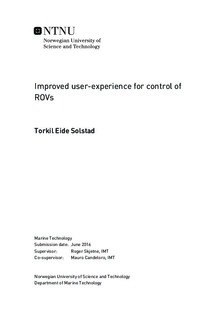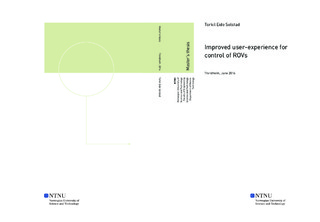| dc.description.abstract | To make small size underwater Remotely Operated Vehicles(ROVs) more accessible for normal users efficient Human-Machine Interface(HMI) solutions are needed. In this theses two solutions are presented. One uses a Windows Surface Pro(WSP) touch pad to control the ROV using a touch based interface. The other solution uses a Oculus Rift(OR) Head Mounted Display(HMD) to control the ROV using head gestures.
The systems are made for a small ROV called uDrone. This is a drone with 6 thruster build by students the fall of 2015. In front of the ROV it has a 180 degree fisheye camera.
The solution presented for the HMD uses head movements and rotations to control the ROV. This can control the ROV both in direct motion control and in automatic control. In addition it uses the 180 degree fisheye camera to create a software panning feature. This way the user can rotate its head in yaw and pitch to see different parts of the video stream. Some form of augmented reality is also introduced by showing the user the position and orientation of the head and ROV in the HMD.
The solution presented for the touch pad uses touch gestures to control the ROV. The video stream is presented on the screen, with depth, heading and position information shown on top. To control the ROV in direct motion control two joysticks on the touch pad are used. In auto depth/heading/position control new desired positions are send to the controllers based on the moving of indicators done by the user. These indicators are shown together with the actual position making it easy to see both the desired and the actual position at one time.
Both solutions are tested the ROV uDrone in the Mc lab at NTNU Tyholt. The HMD control worked fine. The connection with a 180 degree camera and the software panning connected with the yaw control worked very well. The control of surge and sway using head gestures did not feel natural, and users preferred using game controllers.
The touch pad interface gave a better user experience in auto control modes, compared to writing numerical values to the controllers. In the direct motion control the use of joysticks on the screen did not work that good, and should be improved. | |

